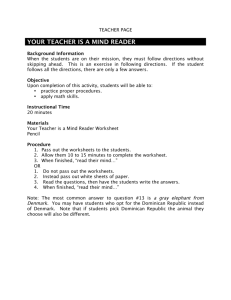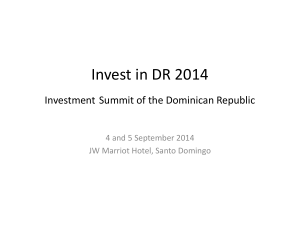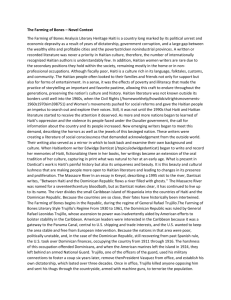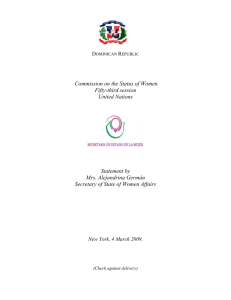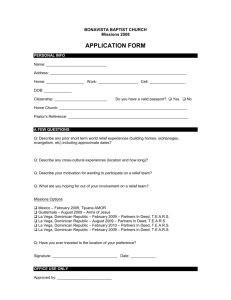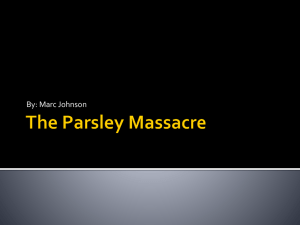Elizabeth Trainor
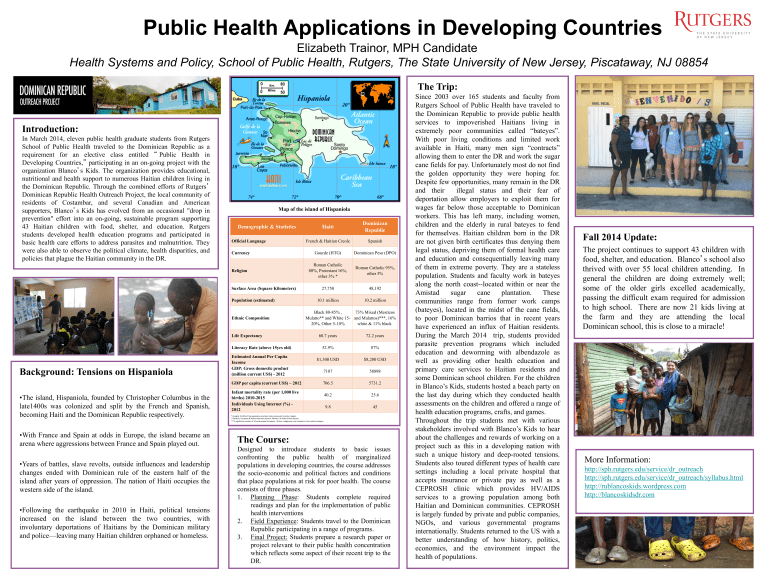
Public Health Applications in Developing Countries
Elizabeth Trainor, MPH Candidate
Health Systems and Policy, School of Public Health, Rutgers, The State University of New Jersey, Piscataway, NJ 08854
Introduction:
In March 2014, eleven public health graduate students from Rutgers
School of Public Health traveled to the Dominican Republic as a requirement for an elective class entitled
“
Public Health in
Developing Countries,
”
participating in an on-going project with the organization Blanco
’
s Kids. The organization provides educational, nutritional and health support to numerous Haitian children living in the Dominican Republic. Through the combined efforts of Rutgers
’
Dominican Republic Health Outreach Project, the local community of residents of Costambar, and several Canadian and American supporters, Blanco
’
s Kids has evolved from an occasional "drop in prevention" effort into an on-going, sustainable program supporting
43 Haitian children with food, shelter, and education. Rutgers students developed health education programs and participated in basic health care efforts to address parasites and malnutrition. They were also able to observe the political climate, health disparities, and policies that plague the Haitian community in the DR.
Background: Tensions on Hispaniola
•The island, Hispaniola, founded by Christopher Columbus in the late1400s was colonized and split by the French and Spanish, becoming Haiti and the Dominican Republic respectively.
•With France and Spain at odds in Europe, the island became an arena where aggressions between France and Spain played out.
•Years of battles, slave revolts, outside influences and leadership changes ended with Dominican rule of the eastern half of the island after years of oppression. The nation of Haiti occupies the western side of the island.
•Following the earthquake in 2010 in Haiti, political tensions increased on the island between the two countries, with involuntary deportations of Haitians by the Dominican military and police—leaving many Haitian children orphaned or homeless.
Map of the island of Hispaniola
Demographic & Statistics
Official Language
Currency
Haiti
Dominican
Republic
Spanish French & Haitian Creole
Gourde (HTG) Dominican Peso (DPO)
Religion
Surface Area (Square Kilometers)
Population (estimated)
Roman Catholic
80%, Protestant 16%, other 3% *
Roman Catholic 95%, other 5%
27,750
10.1 million
48,192
10.2 million
Ethnic Composition
Black 80-85% ,
Mulatto** and White 15-
20%, Other 5-10%
73% Mixed (Mestizos and Mulattos)***, 16% white & 11% black
Life Expectancy 60.7 years
Literacy Rate (above 15yrs old)
Estimated Annual Per Capita
Income
GDP: Gross domestic product
(million current US$) - 2012
52.9%
$1,300 USD
7187
GDP per capita (current US$) – 2012 706.5
Infant mortality rate (per 1,000 live births) 2010-2015
Individuals Using Internet (%) -
2012
* Roughly 25-50% of the population practices Vodou along with another religion
**Mestizo: European & Native American descent, Mullato: of white & black decent
***A significant number of Triracial people (European - African -Indigenous mix) included in the mulatto category .
40.2
9.8
72.2 years
87%
$8,200 USD
58898
5731.2
25.6
45
The Course:
Designed to introduce students to basic issues confronting the public health of marginalized populations in developing countries, the course addresses the socio-economic and political factors and conditions that place populations at risk for poor health. The course consists of three phases.
1.
Planning Phase: Students complete required readings and plan for the implementation of public health interventions
2.
Field Experience: Students travel to the Dominican
Republic participating in a range of programs.
3.
Final Project: Students prepare a research paper or project relevant to their public health concentration which reflects some aspect of their recent trip to the
DR.
The Trip:
Since 2003 over 165 students and faculty from
Rutgers School of Public Health have traveled to the Dominican Republic to provide public health services to impoverished Haitians living in extremely poor communities called “bateyes”.
With poor living conditions and limited work available in Haiti, many men sign “contracts” allowing them to enter the DR and work the sugar cane fields for pay. Unfortunately most do not find the golden opportunity they were hoping for.
Despite few opportunities, many remain in the DR and their illegal status and their fear of deportation allow employers to exploit them for wages far below those acceptable to Dominican workers. This has left many, including women, children and the elderly in rural bateyes to fend for themselves. Haitian children born in the DR are not given birth certificates thus denying them legal status, depriving them of formal health care and education and consequentially leaving many of them in extreme poverty. They are a stateless population. Students and faculty work in bateyes along the north coast--located within or near the
Amistad sugar cane plantation.
These communities range from former work camps
(bateyes), located in the midst of the cane fields, to poor Dominican barrios that in recent years have experienced an influx of Haitian residents.
During the March 2014 trip, students provided parasite prevention programs which included education and deworming with albendazole as well as providing other health education and primary care services to Haitian residents and some Dominican school children. For the children in Blanco’s Kids, students hosted a beach party on the last day during which they conducted health assessments on the children and offered a range of health education programs, crafts, and games.
Throughout the trip students met with various stakeholders involved with Blanco’s Kids to hear about the challenges and rewards of working on a project such as this in a developing nation with such a unique history and deep-rooted tensions.
Students also toured different types of health care settings including a local private hospital that accepts insurance or private pay as well as a
CEPROSH clinic which provides HV/AIDS services to a growing population among both
Haitian and Dominican communities. CEPROSH is largely funded by private and public companies,
NGOs, and various governmental programs internationally. Students returned to the US with a better understanding of how history, politics, economics, and the environment impact the health of populations.
Fall 2014 Update:
The project continues to support 43 children with food, shelter, and education. Blanco
’
s school also thrived with over 55 local children attending. In general the children are doing extremely well; some of the older girls excelled academically, passing the difficult exam required for admission to high school. There are now 21 kids living at the farm and they are attending the local
Dominican school, this is close to a miracle!
